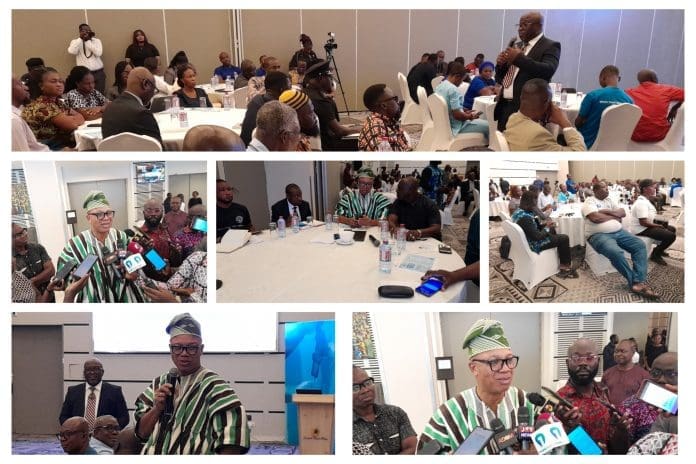Ghana Water Ltd (GWL) is fighting an uphill battle against massive commercial water losses, with the new Managing Director, Adam Mutawakilu, revealing a staggering 52% non-revenue water rate as of December 2024. This disclosure came during a crucial one-day Stakeholder Engagement Workshop held in Accra on Monday, September 29, under the theme: “Addressing Commercial Water Losses in the Delivery of Urban Water Supply,” sponsored by the World Bank.
In an exclusive interview on the sidelines of the workshop, Mr Mutawakilu outlined the grim state of affairs he inherited and detailed the aggressive measures now being implemented to stabilise the utility’s finances and infrastructure.
The Challenging Inheritance
Taking office in February 2025, MD Mutawakilu was confronted with a company in crisis. “The situation was quite challenging,” he admitted. The liabilities were immense: a hefty GHs 1.8 billion owed for electricity and unpaid bills to third-party suppliers. Compounding the financial woes was low revenue, an aging infrastructure, and a substantial portion of total revenue—about 46%—going toward salaries, right before a scheduled biennial salary negotiation.
Critically, the non-revenue water (NRW) rate—water produced but not billed—stood at an alarming 52%. Mr. Mutawakilu estimates that a worrying 80% of this lost water is due to commercial losses, rather than technical issues like burst pipes.
“I needed time to study the system… to know how Ghana Water Ltd operates,” he said. After a few months of assessment, the MD rolled out a set of bold policies starting in July.
Aggressive Turnaround Strategy Bears Fruit
The MD’s turnaround plan is already yielding results.
1. Tanker Ban on Hydrants: The first immediate step was a three-month ban, implemented from July to September, preventing water tankers from drawing water from GWL hydrants. This was a direct move to ensure more water reaches regular, paying customers and
to assess the impact on consumption and revenue.
2. Revenue Enhancement Teams: In July, GWL launched specialized Revenue Enhancement Teams. Currently comprising three teams, they are tasked with aggressively pursuing revenue recovery based on internal data. While acknowledging that three teams are “inadequate” for a city the size of Accra, the MD committed to expanding the force to seven teams by the end of December and ten by March 2026, investing in new, reliable pickup vehicles for their operations.
The initial impact of these measures has been positive. “In August, we’ve seen an improvement in revenue by 20%,” the MD reported, further noting that the non-revenue water rate dropped from 52% to 50% in the same month. He expressed confidence that the September figures would show a “further drop.”
“It needs continuous and consistent effort for all staff to adjust to the new reality, and it needs commitment from management and the board, and I can assure you the board and the management we’re all committed,” he stated.
‘Galamsey’ Skyrockets Water Treatment Costs
The shadow of illegal mining, or ‘galamsey,’ continues to plague GWL’s operations and finances. Mr. Mutawakilu highlighted the drastic
increase in the cost of treating water due to the high turbidity caused by mining activities.
Since 2017, the utility has been forced to switch from the conventional, cheaper aluminum sulphate (alum) to the more effective, but dramatically more expensive, polyelectrolytes in treatment plants across Central, Western, Ashanti, and Eastern Regions.
“The cost of alum, if it is GHs 1.00, that of polyelectrolyte is GHs 5.00,” the MD explained, noting a five-fold increase in chemical costs.
Even more damaging is the economic loss from forced shutdowns. When turbidity levels exceed the treatment plant’s capacity, production must stop temporarily to protect the machinery. The MD estimated that if three or four plants are shut down, the revenue loss can be immense, potentially reaching GHs 12 million a month.
Mixed Results from Anti-‘Galamsey’ Interventions
On the effectiveness of the police and military’s anti-‘galamsey’ efforts, the MD said the data is mixed. A 2024-2025 analysis of river turbidity showed that in some rivers, the turbidity has decreased, while in others, it has unfortunately increased.
“It’s quite a difficult situation because we call them externalities and we call it negative externalities. The activities of someone has direct impact on us which we are not part of,” he lamented, comparing the situation to being forced to inhale second-hand smoke.
Workshop Focuses on Solutions
The workshop itself brought together a diverse group of stakeholders, including representatives from the Tanker Owners and Drivers Association, landlords, tenants, customers, security agencies, journalists, the Public Utilities Regulatory Commission (PURC), and the State Institutions and Governance Authority (SIGA).
Harold Esseku, Task Lead for the GAMA Water and Sanitation Project at the World Bank, provided remarks on the critical issue of water losses.
The participants broke out into three groups to discuss:
Legal Framework & Media Collaboration for Public Awareness Planning
Stakeholder Responsibility Matrix Development
The collaborative effort signals a widespread recognition that tackling GWL’s challenges—from commercial losses to the impact of ‘galamsey’—requires a unified national approach.
With the new MD signaling a firm hand and a data-driven approach, will GWL be able to maintain its positive revenue trend and bring the crippling non-revenue water rate under control by the end of the year?
By Kingsley Asiedu
Source: newsghana.com.gh











